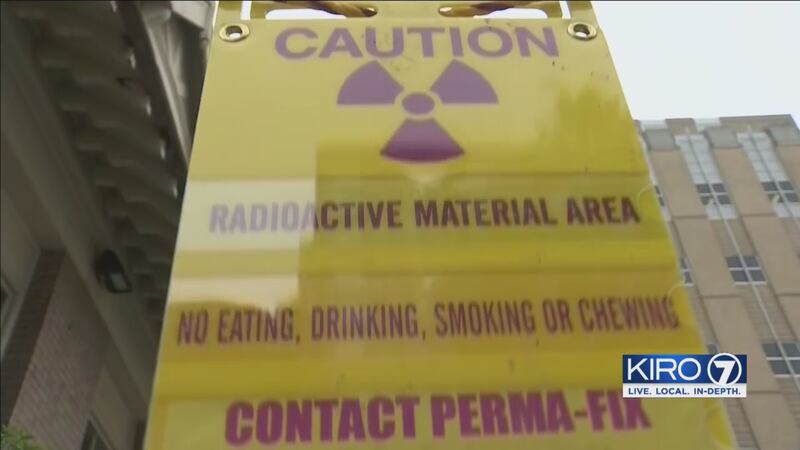SEATTLE — Two and a half months after a radiation spill at the Harborview Medical Center- University of Washington building, crews finally removed a piece of radioactive piece equipment from the campus Wednesday.
>> RELATED: Aftermath of radiation leak at UW Harborview building continues
It's a major step in addressing the radiation leak that happened May 2, but the U.S. Department of Energy says there is still a lot of work ahead to get the building completely safe.
The DOE brought in dozens of people after the leak to handle the situation, and staffing reached a peak this week, when 70 people were brought in to help coordinate moving the radioactive source to a DOE lab in Richland.
>> RELATED: Critical medical research inside UW facility at risk of being lost
Only Chopper 7 was overhead capturing the scene as crews loaded up radioactive materials into a giant, lead-lined metal cylinder. The container is called RH-72B and is licensed by the U.S. Nuclear Regulatory Commission for the safe transport of radioactive material.
“It’s very heavy, tens of thousands of pounds total,” said Al Stotts, a spokesperson for the DOE.
Scroll down to continue reading
More news from KIRO 7
- Feds: Microsoft worker stole millions in digital currency
- Undocumented immigrant arrested while asking ICE for stay of deportation, his legal team says
- Level III sex offender accused of molesting 9-year-old girl in Kent
- Caught on camera: Lifesaving medicine stolen from heart transplant recipient
- Do you have an investigative story tip? Send us an email at investigate@kiro7.com
“We've reached the conclusion of the first major task. Tthe damaged source has been removed safely from the building behind us,” Stotts said.
☢️⚠️ Found out the radioactive source is finally removed from this building on HMC’s campus! Chopper7 pic shows some of the work.
— Deedee Sun (@DeedeeKIRO7) July 17, 2019
2.5 months after radiation leak, US Dept of Energy is STILL working on cleanup. I’m told it could takes weeks or months longer. @KIRO7Seattle 5pm pic.twitter.com/6XUzPXiw1e
The DOE’s National Nuclear Security Administration said there is still significant cleanup work ahead.
Back in May, federal contractors were working to remove an old machine called an irradiator that was being used to sterilize blood.
KIRO7 learned after the spill that crews were working to take out the radioactive part of the machine with a grinder when something went wrong and they spilled a fine radioactive powder containing cesium-137.
>> RELATED: Hazmat response for ‘radioactive breach' in Seattle's First Hill Neighborhood
The powder also got inside the Research and Training Building at 300 Ninth Ave, possibly through the building’s heating, ventilation and air conditioning system.
“Strikes a little close to home in this particular instance,” said Paul Prieste, who stopped to watch the crews work Wednesday.
“I couldn't believe it. There were firetrucks all up and down here on both sides of the street,” said Edward Bardot, who lives nearby.
Hazmat crews sealed off the area, and the building has been shut down since, meaning hundreds of people can’t come to work.
This week the DOE brought in heavy equipment and a large crane to transport the radioactive part of the irradiator – a 1-foot-long by 1-inch-wide capsule.
It was tucked into the giant metal cylinder, which is bookended by large shock absorbers.
“Should there have been any sort of accident, those ends would've protected the cylinder in the middle,” Stotts said. “Finally, after a lot of time and effort, we were able to remove the source safely."
The next step is a focus on cleanup, which could take weeks or even months longer.
The DOE says at the lab in Richland, the radioactive capsule will be measured to determine how much material is left and how much was spilled. The DOE is investigating what went wrong that caused the leak in the first place.
The DOE says it is the first breach of a radioactive source in the DOE Off-Site Source Recovery Program.
Statement from the DOE:
The radioactive source that was accidentally breached May 2 at the University of Washington Research and Training Building in Seattle was safely removed from the building Tuesday evening, July 16, and transported to Pacific Northwest National Laboratory (PNNL) in Richland, WA, for forensic analysis. The breach occurred while a piece of equipment was being removed by U.S. Department of Energy contractors. Once the analysis is complete, the capsule will be re-packaged and prepared for shipment to a permanent waste disposal facility.
PNNL has the facilities and staff to do a thorough analysis of the damaged source. The work will be conducted by PNNL scientists and engineers in their Radiochemical Processing Laboratory (RPL). This unique facility has long been used by PNNL to develop solutions needed to clean up radiological and hazardous waste, safeguard the U.S. and its allies against nuclear proliferation, and ensure safe operation of nuclear power plants.
Now that the source has been removed, all contaminated areas in the Research and Training Building will be remediated by the U.S. Department of Energy and its contractors to a level that meets the “free release” standard the Washington State Department of Health sets for allowing the general public -- including building occupants and laboratory personnel and facilities and maintenance personnel – to be in the building. A timeline for reoccupation is pending.
Cox Media Group








